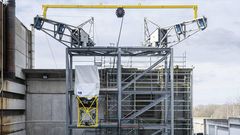The European construction sector is the biggest industrial employer in the European Union, contributing around 9% of GDP. It has an annual turnover of € 1,200,000 million and a direct workforce of 14 million people.
Within the construction sector there is a gap regarding to the automation level of the prefab wall manufacturing and installation. Hephaestus aims to diminish this “automation gap” between the off-site manufacturing and on-site installation.
Our Chair of Building Realisation and Robotics under Prof. Bock is part of the research team. They are in charge of the scientific and technical management of the Hephaestus project. The chair plays a special role in the design, simulation and prototyping of the end-effector modular kit. Finally, Prof. Bock’s team will be responsible for the methodology and protocol definition for the use of cable robots in construction and built environment.
Apart from the recent public attention following the Euronews report, the project has previously been awarded with the Best Paper Award at the ISARC2020 in Japan. The full paper is available online and the Euronews report can be found on their website.
Hephaestus addresses novel concepts to introduce Robotics and Autonomous Systems use in the Construction Sector where at this moment the presence of this type of products is minor or almost non-existent. The project focuses to give novel solutions to one of the most important parts of the construction sector which is the part related to the facades and the works that need to be done when this part of a building is built or need maintenance. A new automatized way to install these products is proposed, providing at the end a whole solution not only highly industrialized in production but also in installation and maintenance, thus ensuring higher levels of on-site safety.
Hephaestus is mainly based on a cable-driven robot and integrates several technologies that are already developed into a multiple job performer. Besides the cable-driven robot, there is a modular end-effector kit.
This modular end-effector kit is capable of hosting several tools. From one side, it can host task accomplishing tool, which can be different at each time where Hephaestus is applied. On the other side, it also hosts all the accessory devices that are necessary for the sensing and controlling the system.
The Multi-functionality of the Hephaestus might be its biggest advantage: Hephaestus solution would be capable of accomplishing several tasks within the built environment, for instance, scanning of the building structure to obtain high accurate plans of its final state and the connection with the BIM model of the building, installation of prefabricated panels, painting, cleaning a curtain wall in a high-rise, replacing damaged elements, repair of cracks, maintenance of possible solar cells etc.
